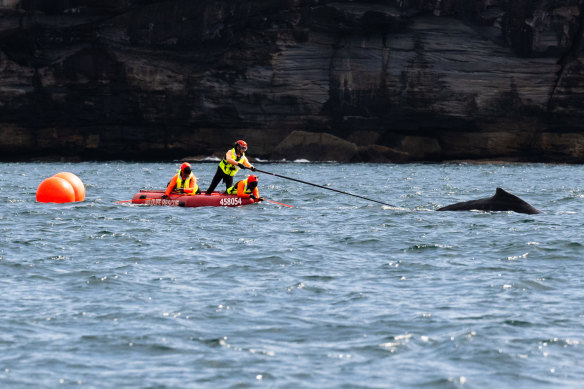This was published 10 months ago
Whale leads rescuers on harbour chase, before slice of freedom
By Nick O'Malley and Caitlin Fitzsimmons
In the end, the final moments of the long chase around Sydney Harbour were oddly abrupt.
Chris Borrow-Jones, a national parks officer who can more often be found fighting fires than freeing whales, leant forward over the bow of an inflatable outboard dwarfed by the humpback that was about 13 metres long.

The rescue workers cut the whale free of nylon cord just after 11am. Credit: Janie Barrett
While bobbing off Washaway Beach, across the water from Balmoral, Borrow-Jones made a few deft cuts with a knife attached to a long pole, and suddenly the nylon fishing cord that had been tangled around the whale’s tail fluke for at least 22 hours was gone.
The animal made a beeline out of the Sydney Heads and started swimming south, breaching once or twice more before it disappeared. Humpbacks migrate to Antarctica in spring to feed on krill.
NSW National Parks and Wildlife Service Area Manager Ben Khan said there were no concerns for the whale’s safety.
“Once it was cut free, it took off free swimming, and looked fantastic,” Khan told reporters.

Rescuers celebrate after the whale they had just freed turned and swam for the open sea.Credit: Janie Barrett
He said the size of the whale indicated it was a sub-adult – the whale equivalent of an adolescent. The sex is not known.
Tired and happy, Borrow-Jones, boat driver Tim Blackmore and team leader Luke McSweeney, all national parks rangers, turned their little boat around and joined the rest of the rescue crew gathered in the waters off Balmoral.
The wider team included Port Authority of NSW and NSW Maritime Services officers and volunteers from the Organisation for the Rescue and Research of Cetaceans in Australia (ORRCA). A cheer went up as the vessels came together.
The whale’s ordeal had begun at least the day before. At around 1pm on Thursday, whale watching boat Fantasea spotted the animal trailing the line behind it, and reported it to ORRCA. The whale then swam into the harbour.
The charity liaised with the National Parks and Wildlife Service to plan the response, and provided support with a licensed drone and citizen scientist tracking the whale from shore.
McSweeney said it was not uncommon for a distressed whale to seek sanctuary, nor for them to become entangled in abandoned commercial fishing gear, especially at this time of year.
On Thursday afternoon the rescue team attached buoys and a tracking device to the whale, but were unable to free it before dark.
Overnight the tracking device came free, but not long after sunrise, the rescue workers could be seen pursuing the whale north-east from Taylors Bay. The little inflatables were fast behind the animal, while the larger boats kept a protective cordon as commuters buzzed past on ferries.
Just after 9am, in what McSweeney describes as a “kegging operation”, the team added larger floats to the line attached to the whale.
The aim was to slow it and tire it to the point where it was safe to free it.
From that moment on, the operation at times resembled the movie Jaws as the rescuers followed the orange buoys about the sea for several hours.
The whale moved erratically and often quickly, lunging across the harbour’s coves and bays and then hugging the coastline.
At times its cries and groans could be heard over the sounds of the wind, boat engines, helicopters and drones.
Towards 11am the whale slowed and Blackmore made the first attempt. A few minutes later, Borrow-Jones leant forward again and the animal was freed.
McSweeney said it was a simple cut in the end.
“The challenge with that whale was the fact it had so much energy, and it took quite a long time for us to tire it out so we could get in and do that cut safely,” he said.
McSweeney, who is normally based at Ku-ring-gai Chase National Park, but also serves as an NPWS large whale disentanglement team leader, said almost all of the team’s rescues ended in success.
The animal freed on Friday morning was “a healthy strong animal with no injuries on it”, and McSweeney was confident it would continue its migration.
NSW Maritime principal manager Shane Davey said the whale was swimming in the middle of the Manly to Circular Quay route, but the operation was able to occur without any disruption to the timetabled services.
The International Whaling Commission estimates that globally, 300,000 whales and dolphins die of entanglements every year, making it the biggest threat to whales besides the stress of climate change and overfishing depleting its food source.
ORRCA second vice president Jessica Fox said there were three other current whale entanglements reported up and down the coast, including near Newcastle, Forster and Sydney.
“They haven’t been sighted for the last two days so we do ask that if anyone is out by the water, to please keep a lookout for entangled whales,” Fox said.
“We ask that people collect the GPS location, the direction of travel, the approximate distance from shore, and phone that through to our hotline.”
ORRCA hotline: 02 9415 3333
Get to the heart of what’s happening with climate change and the environment. Sign up for our fortnightly Environment newsletter.